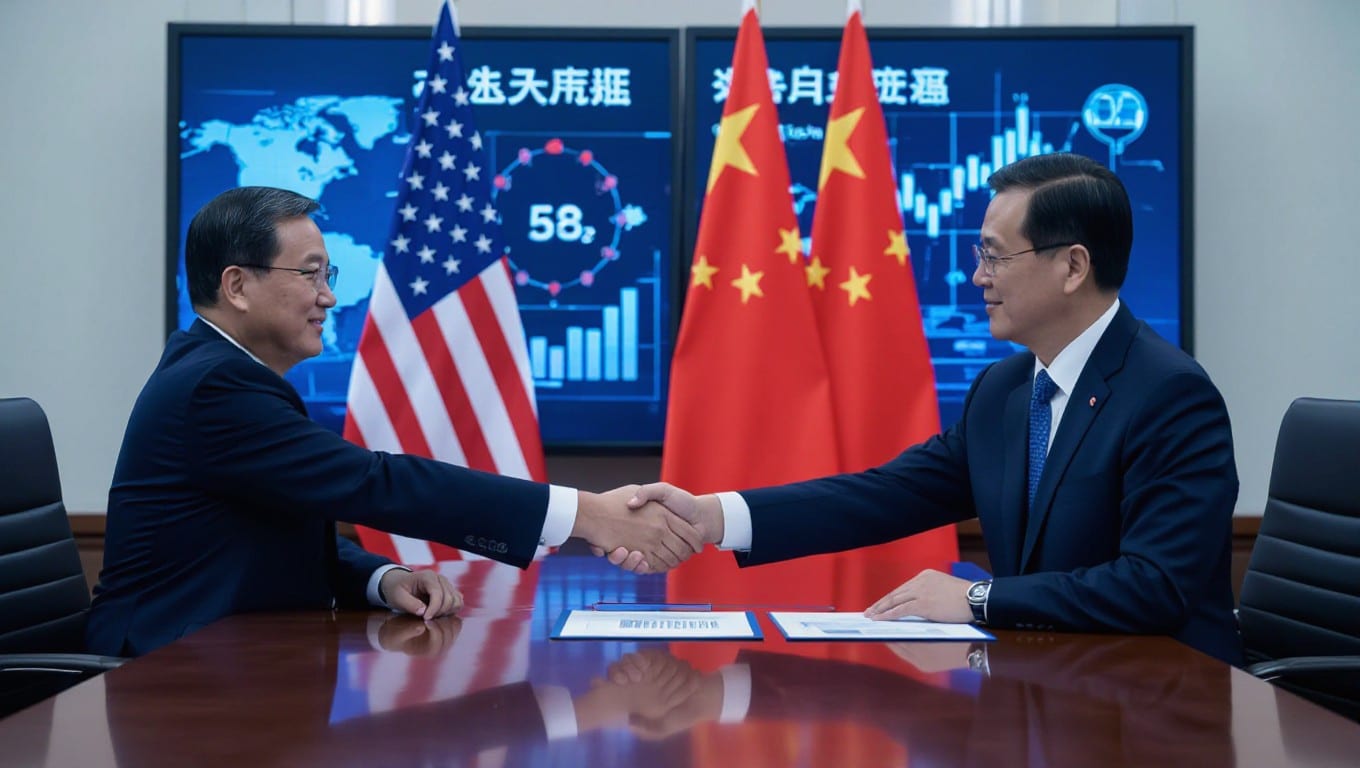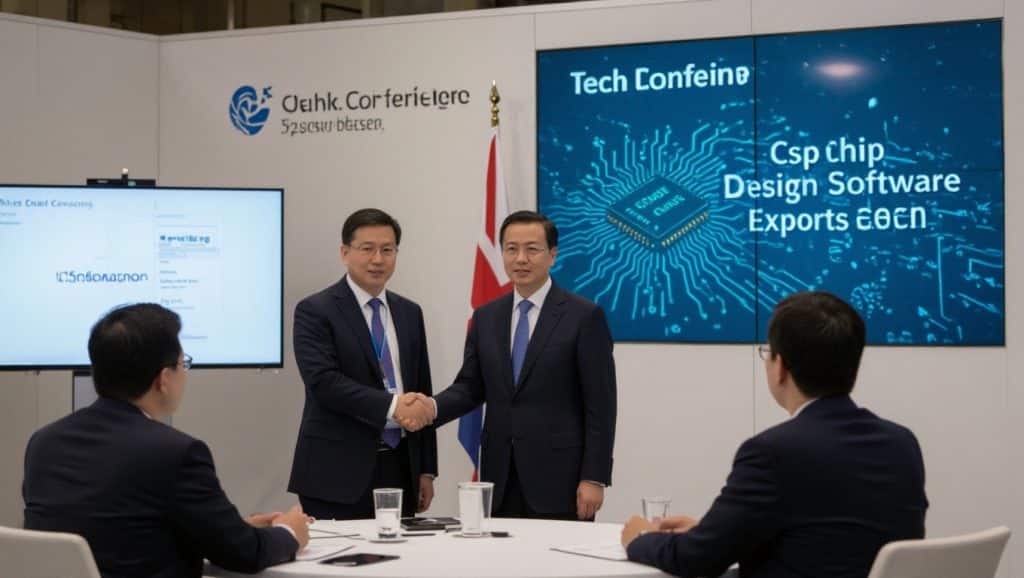Chips play a vital role in today’s technology landscape, and you should know that the US has officially lifted export restrictions on chip design software to China after recent London trade negotiations. This move reverses earlier export controls that threatened to disrupt China’s semiconductor industry and signals a significant step towards easing tensions between the two global powers. As a result, companies are restoring access to critical software tools, reflecting a positive shift in trade relations that could impact your understanding of the semiconductor market and international technology trade dynamics.
A New Era in US-China Trade Relations
The London trade talks set a significant tone for easing tensions between the US and China, as seen in the swift lifting of export curbs on chip design software, ethane, and jet engines. These moves mark a shift from aggressive restrictions to a tentative restoration of cooperation, reflecting both nations’ recognition that sustained economic engagement benefits your industries on both sides. However, with tariffs still high and the truce’s expiration looming in August, this new phase remains fragile, demanding careful navigation to avoid renewed conflicts that could disrupt global supply chains.
Overview of the Recent Trade Agreement
The latest agreement primarily focuses on resolving rare earth export disputes, with China agreeing to expedite rare earth shipments under existing licensing regimes while the US rescinded export controls on key technologies like chip software and ethane. This mutual rollback signals an intent to stabilize sectors vital to both economies—semiconductors, plastics, and aerospace—though it notably sidesteps tariff reductions, leaving ongoing trade barriers intact for now.
Implications for Future Economic Cooperation
You should view this trade accord as a foundation for incremental progress rather than a comprehensive resolution. By reinstating access to important technologies and resources, it enhances your ability to rebuild disrupted supply chains and encourages collaboration on strategic industries, but persistent tariffs and regulatory uncertainties continue to impose risks on investment and innovation.

The Impact of Lifting Export Restrictions
The removal of export controls on chip design software and related technologies marks a significant shift in US-China trade relations, easing pressure on China’s semiconductor sector. You’ll notice this move restores critical supply chains and revives cooperation crucial for innovation in both countries. While broader tariffs remain, the easing of software, ethane, and jet engine curbs signals a selective thaw, potentially stabilizing sectors that underpin advanced technology development and industrial production linked to national security and economic growth.
Restoration of Chip Design Software Access
Synopsys, Cadence, and Siemens are actively reinstating access to their Electronic Design Automation (EDA) software in China, vital for microchip design. By regaining these tools, you can expect semiconductor designers in China to resume work with leading-edge platforms that support 70% of their market. This restoration not only enables ongoing chip development but also mitigates operational disruptions caused by the May export restrictions, allowing companies to plan and execute projects with restored confidence.
Effects on China’s Semiconductor Industry
China’s semiconductor industry stands to benefit immensely as access to Western EDA software returns. These tools are foundational for designing advanced chips, powering everything from consumer electronics to defense systems. With the trio of suppliers controlling the majority share of China’s EDA market, lifting curbs removes a major bottleneck that threatened to stall innovation and production capacity, helping Chinese firms sustain their competitiveness in the global semiconductor race.
China’s reliance on imported EDA software has long been a vulnerability, given that these platforms provide the complex simulations and design frameworks necessary for modern chip fabrication. Without them, Chinese companies faced potential delays and quality compromises. Regaining access enables them to maintain product roadmaps, improve chip performance, and accelerate development cycles. This change also impacts China’s broader ambition to reduce semiconductor dependency by strengthening domestic capabilities, as uninterrupted software access provides critical support during this transition.
The Strategic Reversal of Export Controls
The US decision to lift export restrictions on chip design software to China marks a significant strategic recalibration amid ongoing trade tensions. After abruptly cutting off crucial Electronic Design Automation (EDA) tools in May, the reversal signals a shift towards implementing the London trade framework. You’ll see the US easing curbs not only on chip software but also ethane and jet engines, while China commits to expediting rare earth exports. This move reduces disruption for major tech firms and stabilizes supply chains, reflecting a pragmatic approach to balancing national security concerns with economic and diplomatic pressures.
Reasons Behind the Initial Restrictions
The original export curbs targeted critical semiconductor software as part of a broader US strategy to limit China’s access to technologies that could enhance its military and AI capabilities. The restrictions responded to China’s effective choke on rare earth exports—vital materials for electronics and defense—triggering a tit-for-tat escalation. By cutting off the US supply of Electronic Design Automation tools controlling 70% of China’s market, Washington aimed to hinder Beijing’s chipmaking advances that fuel both civilian and military tech developments.
Economic Rationale for the Rescission
Removing the export controls acknowledges the heavy economic costs both sides faced under the restrictions. Nearly half of US ethane exports, primarily used in plastics manufacturing, were destined for China, and suspending shipments caused significant market disruptions. Restoring access to semiconductor software helps companies like Synopsys and Cadence resume normal operations in China’s expansive EDA market while preventing further financial fallout. The decision thus balances safeguarding strategic interests with sustaining vital commercial relationships in a globally intertwined tech industry.

The Broader Context of Rare Earths and Technology
The US-China trade negotiations around chip software and rare earths reveal a complex interdependence. Rare earth minerals, crucial for manufacturing everything from smartphones to advanced weaponry, have become leverage points in diplomatic and economic tensions. Meanwhile, technology exports like Electronic Design Automation software serve as both economic assets and strategic tools. This interplay shapes not just trade flows but also global innovation trajectories and military balances.
Significance of Rare Earths in Global Trade
Rare earth elements underpin a vast range of modern technologies—accounting for over 90% of global processing controlled by China. These minerals are vital in electronics, renewable energy, and defense systems. By imposing export licensing on key rare earths and magnets, China gained a potent strategic advantage, influencing supply chains and pushing the US to respond with export controls of its own.
The Dual Role of Technology in Military and Economic Strength
Technology export controls targeting chip design software reflect concerns beyond commercial competition. Access to cutting-edge semiconductors enables China to advance artificial intelligence and military tech, areas where US restrictions aim to curb rapid Chinese development. How you manage the flow of such technologies determines not only economic dominance but also geopolitical power projection.
The intersection of technology and military strength extends into critical sectors such as AI, aerospace, and cybersecurity, where semiconductor innovation drives performance leaps. For instance, Electronic Design Automation tools are indispensable for designing advanced microchips that power next-generation fighter jets, surveillance systems, and autonomous platforms. By regulating these technologies, the US attempts to impose limits on China’s ability to enhance its military capabilities, illustrating how economic policy instruments double as national security measures. You can see these efforts reflected in both export curbs and diplomatic trade deals, which balance commercial interests with safeguarding strategic advantages.
Short-Term Gains and Long-Term Challenges
The lifting of export restrictions on chip design software and related technologies marks a significant step forward, offering immediate relief for industries on both sides. However, lingering high tariffs and unresolved trade issues pose persistent risks that could undermine this progress. While companies restore operations and supply chains stabilize, you should consider the longer-term uncertainties these tensions create, especially as the current truce approaches its August expiration without clear plans for tariff reductions or addressing broader geopolitical friction.
Immediate Benefits for US and Chinese Companies
With export curbs lifted, firms like Synopsys, Cadence, and Siemens can rapidly resume sales and support to Chinese customers, regaining access to 70% of China’s crucial EDA market. This restoration enables semiconductor design activities in China to recommence more smoothly, while US companies benefit from regained revenue streams and improved supply chain predictability. You can expect faster product development cycles on both sides as critical software and chemical supplies flow more freely.
Unresolved Tariffs and Future Trade Tensions
The current agreement stops short of reducing the steep tariffs both nations maintain, with US duties on Chinese goods hovering around 55% and China’s retaliatory tariffs remaining in place. These barriers continue to weigh heavily on cross-border trade, threatening to reignite tensions once the 90-day truce lapses in August. Businesses must navigate this uncertain terrain where tariff policy remains a potent source of instability.
Despite progress on export controls, the still-elevated tariffs signal that broader trade hostilities are far from resolved. The US combines multiple levies—including a 10% reciprocal tariff imposed in April, a 20% surcharge linked to fentanyl-related grievances, plus pre-existing duties—to sustain a heavy tariff burden on Chinese imports. Meanwhile, China maintains its own tariffs on US goods, forming a complex pattern of tit-for-tat sanctions. This ambiguity complicates planning and investment, as companies face the possibility of renewed escalation if diplomatic talks stall. You should prepare for continued volatility in trade relations that could disrupt supply chains and market access beyond the gains from lifted export restrictions.
Summing up
Upon reflecting on the recent developments, you can see that the US lifting export restrictions on chip design software signals a significant step towards easing trade tensions with China following the London negotiations. This move restores access to crucial technology for China’s semiconductor sector while supporting a broader agreement that includes resuming exports of ethane and jet engines. However, you should be aware that high tariffs remain in place, and ongoing dialogue will be key as both countries navigate this complex trade relationship.

